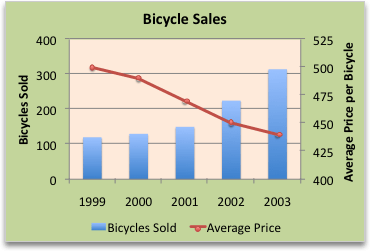

Right Click on the Profit Series and change chart type to a line graph.This chart sits on the top of the original chart. Now the percentage numbers are on the right side of the chart and the flat lines are bars.Right Click on Profit series and choose Format Data Series and choose Secondary Axis and Close.They are this way because the other numbers are larger than the percentages. Profit series are visible (they are the thin lines on the chart).If you want, you can combine these different graph types to create a hybrid. Excel offers a number of different graph types, including bar graphs, line graphs, column graphs and pie graphs. It MUST be this format or the combination option (secondary axis) will not be available. The Excel spreadsheet program allows users to create spreadsheets of data and transform these spreadsheets into charts and graphs for easy data comparison. Highlight the entire table and Insert Column Chart and choose 2-D Column.Notice that the numbers are left aligned. To convert a line to a series of segments, simply highlight the line and select Stacked Segments from the chart type control (see Chart type). Line chart and Column chart and stacked column chart describe in detail the usage of lines and column segments in charts. You need to place a single quotein front of each year to make the number into text. A combination chart combines line and column segments in a single chart. You cannot choose number format and convert to text. Make sure that the year column is in text format.
#How to combine bar and line graph excel code#
In order to do this we will still need to code out the two plots, we will just need to be sure that we state that we want the two plots to share in one axis and be unique in the other.

In other words, you will need a help column, where the average of the first two data is equal to the January Proft (-2%), the average of the second and third data is equal to the February Profit (5%), etc. A vertical line appears in your Excel bar chart, and you just need to add a few finishing touches to make it look right. Only need to reverse the calculation logic of 2 period moving average: now the first data and the moving average (=the original data) is given, and need to calculate the second data. The idea is to create a dummy data series which determines a trendline which equals to the connecting line of the original data points.


The average of the second and third data points is used as the second point in the trendline, etc.” “For example, if Period is set to 2, the average of the first two data points is used as the first point in the moving average trendline. There we can find a Combo chart of Column Line, Column Cluster Line and with Area Chart type. We started to think about moving average trendline, because this is very simple to calculate based on the Period - as you can read on MS office site: First, create a Combo Chart, select the data we want to plot, and then choose Combo chart type from the Insert menu section. Our out-of-the-box idea is to use trendline. Each time you redefine a data series as a contrasting combination chart type, Microsoft Excel displays it behind the series you previously defined. Well, it’s a fact that bubble chart can not be combined with any other charts, so the usual “change series chart type” way will not work. For the same reason, if you combine two chart types that present information similarly but in different orientations - for example, a column and a bar chart - you may be unhappy with your output.


 0 kommentar(er)
0 kommentar(er)
